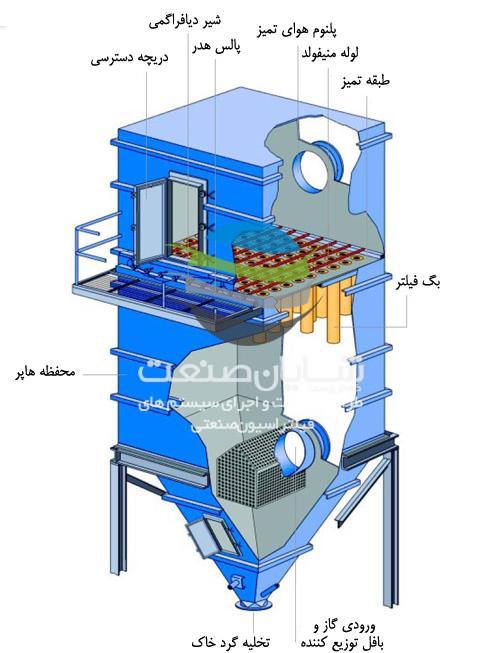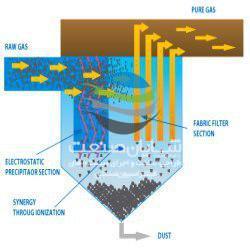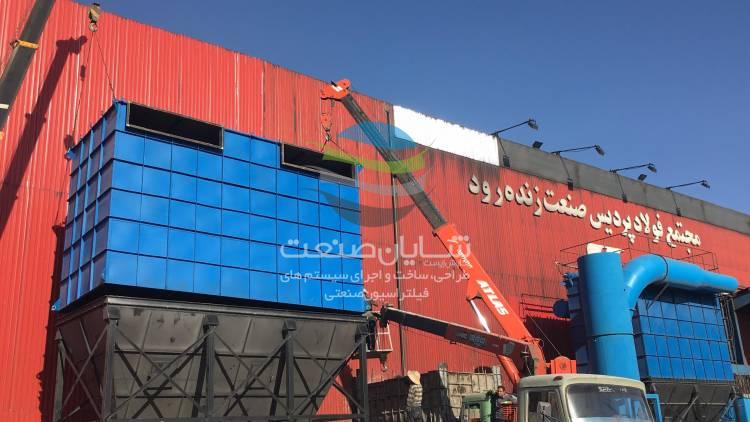What is a bag filter and what is its use?
A bag filter is a container containing a number of bags made of polyester that settle the dust on the outer surface of the bags as the gas containing dust passes through the inlet valve and moves towards the outlet of the filter. Then, at regular intervals by applying an air pulse, the dust on the bag is shaken and poured into the hopper under the filter. In this way, the dust is separated from the gas. Another equipment that is widely used for air dust removal in the cement industry are bag filters. These types of filters have a high dust collection efficiency, which depending on the type of dust is up to 99.9% efficiency. A factor that limits its use is the temperature of the inlet gas, with new advances in the production of bagged fibers, the scope of their use has become wider.
With the new textile products, the bags can withstand temperatures above 200 ° C. The following factors play a key role in bag filters:
Material of bags used Degassing
area
Bag structure and shape
Type of bag dust system The
last case that causes the industry to use pulsed-based dust collection systems. In this type of bag filters, a pulsation of compressed air is done by injecting a pulse of compressed air in a short period of time. These types of filters are widely used in various parts of the cement industry.
Jet pulse filters mainly have six main parts, which are:
Inlet duct and inlet chamber Dust-carrying gas with filter
Fiber bag filter Mesh
plate
Pulse valves
Blower tubes to bags
Exhaust chamber and duct of purified gases
Description of operation process Bag filters
The dust-carrying gas enters the filter and is returned by the baffle to the discharge hoppers. Dusty gas enters one of the filter houses and the larger dust particles move towards the hopper after entering under the influence of their weight force and the rest accumulates on the filter bags. The cleaning process of the bags begins when the dust has accumulated on the bags to such an extent that the flow is difficult to pass.
The function of the inlet section is to reduce the gas velocity and allow large particles to fall freely to the hoppers under the filter, causing a uniform distribution of fine dust particles between the bags. The gas distribution ensures that the gas flow on the bags does not cause excessive wear.
The dust carrier gas goes to the bags and from there enters the cleaning air chamber and is then sent to the chimney by the suction fan. At the same time as the above operation is performed continuously, the pulsed air is periodically blown into the bags periodically through the pulse valves and nozzles by the electrically programmed panel, causing the material to separate from the outer surface of the bags. The separated material enters the harper and from there is directed out of the filter by transmission systems.
Each row of filter bags is cleaned with a separate tube and nozzle installed at the top of the bags using compressed air. For this purpose, compressed air tanks are cleaned. For this purpose, compressed air tanks with complementary diaphragm valves are located at the end of each nozzle. These diaphragm valves are opened and closed by selenoid valves which themselves operate periodically by an electronic controller. The compressed air that comes out of the compressed air tank is blown into the bag through the nozzle blower tubes and the injector tube jet, which is installed just above the bags. Due to the injector property, some clean chamber air is also sucked into the bags. Even six-meter-long bags can be cleaned using this method.
Compressed air pulse that cleans the bags compared to hammer hammer positive and negative electrodes in the electrodes due to the volume of related equipment, such as gearbox motors, hangers, positive and negative anvils, is not depreciated and to mechanical repairs and adjustments. No need to be exhausting.
When using bag filters in dusting combustion gases and cleaning the cleaner, an important issue to consider is the amount of filter bags against high temperature gases. With the changes in the technology of producing cleaners, the use of bag filters has undergone changes, the latest of which is lowering the temperature of the exhaust gases to a temperature of less than 200 ° C. The use of bag filters dehumidifies gases up to 10 mg per cubic meter.

An important factor to consider when determining the area to be dusted is to determine the proper speed of the dusting operation that must be considered. Bag filters are divided according to the type of cleaning method. The cleaning of the bags is done online and offline. In the online mode, the chamber does not leave the production line and is still in the gas path, but in the offline mode, the chamber is separated from the production line and isolated again after the cleaning operation. It opens to the line. Bags can be cleaned in three ways: reverse air method, air jet method, mechanical method.
In the past, mechanical shaking and sometimes reverse air were used. However, Pulse jet cleaning is currently used. In pulse jet bag filters, cylindrical metal shelves called cages are used to prevent the bags from accumulating inside them. The cage and bag hang vertically from a perforated plate called a tube. To separate the layer of soil sitting on the outer surfaces of the bags, a high-pressure compressed air pulse is applied to the open mouth of the bags from above. In other words, the dust that seeps into the filter bags is blown into the hoppers by fast, short air pulses. Dust enters the transmission line to the production line through the hoppers under the filter.
Baghouse
Filter The Baghouse Filter is the bag filter used in the production line process. This type of filter has been used more in recent years to purify the exhaust gases from the main points of the production line and in some cases have replaced electric filters. The main advantage of this type of filter is less impact of the exhaust dust by changing the characteristics of the inlet gas and easier access to less exhaust dust in the range of 10 mg per cubic meter.
Baghouses come in a variety of shapes and sizes, and their base is similar to ordinary bag filters. Baghouses are named after a series of woven and cloth bags woven into a metal enclosure, often made of Orlon nylon, acrylic, Dacron, Teflon, or fiberglass. In general, it can be said that Baghouses can be found in all industries. Industries such as cement, foundry and steel operations, pharmaceutical manufacturers, food manufacturers, chemical manufacturers and. Examples of this. The use of Baghouses is constantly increasing and this is widespread in almost all countries of the world. As mentioned, gas bag filter filters are passed through the filter cloth. Dust particles settle on the surface of the fabric and the layer of dust that forms on the surface of the fabric is separated from the bag by shaking the fabric in different ways and enters the funnel. In order for the dust on the bag not to cause a large pressure drop to pass the gas flow, a large fabric surface is needed, and in order for a large surface of the fabric to fit in a limited space, the filter cloth is turned into a cylindrical bag. It is called a cylinder in a baghouse. The size of a baghouse depends on the volumetric flow rate of the gas and the ratio of the volume flow rate of the gas to the surface of the fabric or A / C. A / C depends on gas concentration, temperature, cleaning method and level of filter technology.
The most important advantages of using pulse jet filters are:
High user efficiency
Low user costs
Resistance to flammable gases, explosive dust particles and…
Easy to use
Durability, long life of bags
Pulse jet filters have the following disadvantages:
High resistance to gas flow
Low efficiency against wet gases
The temperature limit of the inlet gases due to the material of the bags is
suitable for use and the high efficiency of the bag filters depends on the correct choice of the filter and the correct principles of installation, equipment and use. Poor performance of such filters is due to the following factors:
Improper installation equipment (wrong configuration of the intake system, a bug in the system shake dust from the bags, improper installation bags)
incorrect selection of filter (low capacity dust Fyltrnsbt area)
using appropriate sex bags with
high humidity gas inlet
The type of bag used is selected based on the process characteristics of the gas, temperature, humidity, type of gas and the amount of dust particles. The fabric used to dust the exhaust gases from the kiln of raw materials of cement production lines is usually made of fiberglass with membrane coating and made of PTFE, which can withstand temperatures up to 260 ° C. The presence of membrane prevents the entry of fine dust particles into the fabric and prevents the increase of pressure drop between the ends of the bags during operation. But in any case, the pressure drop between the two ends of the bag filters is between 12 to 15 millibars, which is one of the weaknesses of bag filters. Another disadvantage of the bag filter is the fabric temperature tolerance limit of 260 ° C. If the temperature rises above this value, the fabric will be unusable. Cooling towers are also commonly used in bag filters to reduce temperature. Lowering the temperature to 260 ° C is sufficient for the fabric to be tolerable. However, because the decrease in temperature reduces the volumetric flow of gas and thus reduces the required surface of the fabric, for this reason, in bag filters, the temperature is set in the range of 150 to 200 ° C. The most important advantage of the bag filter is that the dust collection efficiency and the amount of dust output do not change significantly with changing temperature, humidity and gas volume. Bags are made of different materials and the following should be considered when choosing a bag:
Gas temperature
Moisture content of dust
Electrical nature of dust particles
Corrosion rate of dust particles
Acid and alkali resistance of fabric Fabric
ability to get rid of dust layer
Ability of fabric in air permeability
Dust particle size
Bag price
in design of fabric dust collectors In addition to inlet gas conditions, the following are also fashionable Comments are:
Pressure drop, vertical velocity of gas between bags and ratio of air to fabric surface
Pressure drop Pressure
drop is one of the most important parameters in the design of fabric filters. This parameter represents the resistance of the filter fabric against the passage of gas flow. Pressure drop is measured in millibars, milligrams or millimeters of water. To measure the pressure drop in fabric filters, the total pressure is measured at two points, which are usually the inlet and outlet of the filter:
Dusting speed and air to fabric ratio
The two words dusting speed and air to fabric ratio can be used interchangeably. The air to fabric ratio is defined by the ratio of air entering the filter per cubic meter per minute to the filtration rate per square meter. The units measured by A / C are:
m/min, cm/s
Higher this ratio means a higher volume of air or gas that is from the surface of the filter cloth.
Vertical gas velocity between bags
The vertical velocity of the gas between the filter bags in a bag filter is called Can velocity. The unit of measurement of this speed is m / min and other common units are ft / min and cm / sec. In filters using the online method, dust particles separated from the surface of the bags during the cleaning operation must move downwards under the influence of their weight force in the filter environment. If the upward velocity of the inlet gas does not exceed the downward velocity of the fall of these particles, the particles return to the dust surface and overshadow the filter operation.
Comparison between bag filter and electrofilter
Approximate comparison of the cost of electrofilters and bag filters as the most widely used filters in the industry. For example, whenever the cost of a bag filter is assumed to be 100 units, an electro-filter device with the same capacity of 400 units is considered.
Electrofilters are one of the best tools for air purification, removal of pollutants, dust and soot. This method has a high efficiency in removing pollutants, dust and soot. It also has high efficiency in removing toxic compounds of carbon monoxide, nitrogen oxides, formaldehyde and toxic gaseous compounds.
Features and function of hybrid filters Hybrid
filters are one of the types of dust collection systems that combine electrofilter and bag filter technology. The resulting system is durable and cost-effective and has a high dusting power. The design of this type of filter with the simultaneous use of the two technologies mentioned above, has made it possible to design with a higher air-to-filtration ratio in the bag. This reduces the surface area of the fabric and as a result the number of bags, the number of gauges, the valves related to the percussion system in the bag part. Reducing the number of these parts ensures greater efficiency and durability of the device and lower maintenance costs. Although electrofilters have high mechanical strength and temperature resistance, they can be very expensive when the output is less than 10 mg / m3.
Electrofilters have a lower pressure drop than bag filters in different volumes of gas. Also, the filter bag can separate more dust than the electrofilter and work independently of gas and dust conditions, but they are sensitive to temperature. If increasing the efficiency of the filter is intended by increasing the efficiency of the cement production line, the electrofilter will be very expensive. Converting an electrofilter to a bag filter requires a new, more fatherly fan than the previous electrofilter fan. Therefore, in order to increase the efficiency of dust collector systems and use the advantages of electrofilters and bag filters simultaneously, the idea of combining the above two systems led to the production of composite or hybrid filters in the family of dust collectors. The interaction of two electrofilter and bag filter systems in a single system has increased the efficiency of the system in the absorption of fine dust particles and the formation of an integrated, stable and economical system.
Description of hybrid filter operation
In a hybrid filter, two methods of dusting are used simultaneously.
Dust absorption using electrostatic force in the electric field
Dust separation using filter cloth in the hybrid filter bag.
Taking advantage of the two methods of dusting, it actually creates a synergy between the above two functions, which results in very valuable results.
The hybrid filter consists of an electrical part and a separate bag section, both of which are housed in the same compartment. The electrical part is similar to an electric field electrofilter, and the bag part consists of a set of bags that is almost identical to a bag filter. The gas stream first enters the electrical part and under the influence of the electrostatic field, about 90 to 95% of the dust is absorbed by the plates. The remaining dust particles enter the bag and settle on the surface of the bag. These charged particles form a layer of dust on the bags with a porous space that facilitates the passage of gas through the dust layer. This makes the pressure drop much lower than the bag filter, despite the fact that the gas passing through the fabric of the hybrid filters is much faster than the bag filter, which results in the possibility of using less fabric surface for a certain volume of gas (A / C). ) is.
Advantages of using a hybrid system
Excellent particle adsorption efficiency of more than 99.99% of
bags in this system due to protection against
settling of large particles has a longer service life and higher efficiency.
Smaller equipment size due to the use of 65 to 75% of conventional bag filter equipment and a percentage of use of conventional electrofilter components
. Optimal energy consumption
, maintenance and upgrade of the system due to no need to add control parameters
as previously provided in filters The hybrid is that due to the absorption of most of the dust in the electrical part, much less dust load will enter the bag section, which will reduce the frequency of sending cleaning pulses and, consequently, increase the life of the bags, increase the life of Diaphragm and pilot. Valve as well as reducing the consumption of compressed air.


